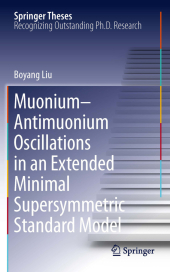 Neuerscheinungen 2014Stand: 2020-02-01 |
Schnellsuche
ISBN/Stichwort/Autor
|
Herderstraße 10
10625 Berlin
Tel.: 030 315 714 16
Fax 030 315 714 14
info@buchspektrum.de |

Boyang Liu
Muonium-antimuonium Oscillations in an Extended Minimal Supersymmetric Standard Model
2011. 2014. xi, 67 S. 3 Tabellen. 235 mm
Verlag/Jahr: SPRINGER, BERLIN; SPRINGER NEW YORK; SPRINGER 2014
ISBN: 1-461-42805-X (146142805X)
Neue ISBN: 978-1-461-42805-3 (9781461428053)
Preis und Lieferzeit: Bitte klicken
This innovative volume investigates muonium-antimuonium oscillations in an extended, minimal supersymmetric standard model. The text helps establish relationships between the experimental result of the muonium-antimuonium oscillation process and model parameters.
This innovative work investigated two models where the muonium-antimuonium oscillation process was mediated by massive Majorana neutrinos and sneutrinos. First, we modified the Standard Model only by the inclusion of singlet right-handed neutrinos and allowing for general renormalizable interactions producing neutrino masses and mixing. The see-saw mechanism was employed to explain the smallness of the observed neutrino masses. A lower bound on the righthanded neutrino mass was constructed using the experimental limits set by the nonobservation of the muonium-antimuonium oscillation process. Second, we modified the Minimal Supersymmetric Standard Model by the inclusion of three right-handed neutrino superfields. The experimental result of the muonium-antimuonium oscillation process generated a lower bound on the ratio of the two Higgs field VEVs. This work helps to set up relationships between the experimental result of the muonium-antimuonium oscillation process and the model parameters in two specific models. Further improvement of the experiment in the future can generate more stringent bounds on the model parameters using the procedure developed by this work.
Introduction to muonium-antimuonium oscillation.- Muonium-antimuonium oscillation in a modified Standard Model.- Supersymmetry and the Minimal Supersymmetric Standard Model.- The muonium-antimuonium oscillation in the extended Minimal Supersymmetric Standard Model.- The constraints from the muon and electron anomalous magnetic moment experiments.- Conclusions.
Boyang Liu, Chinese Academy of Sciences, boyangleo@gmail.com


